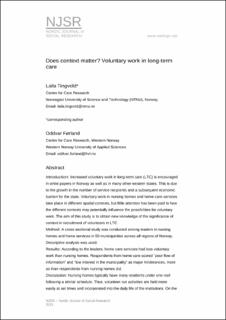| dc.contributor.author | Tingvold, Laila | |
| dc.contributor.author | Førland, Oddvar | |
| dc.coverage.spatial | Norway | en_US |
| dc.date.accessioned | 2021-10-21T08:49:56Z | |
| dc.date.available | 2021-10-21T08:49:56Z | |
| dc.date.created | 2021-08-16T10:47:41Z | |
| dc.date.issued | 2021 | |
| dc.identifier.citation | Tingvold, L., & Førland, O. . (2021). Does context matter? Voluntary work in long-term care. Nordic Journal of Social Research, 12(1), 155–180. | en_US |
| dc.identifier.issn | 1892-2783 | |
| dc.identifier.uri | https://hdl.handle.net/11250/2824409 | |
| dc.description.abstract | Introduction: Increased voluntary work in long-term care (LTC) is encouraged in white papers in Norway as well as in many other western states. This is due to the growth in the number of service recipients and a subsequent economic burden for the state. Voluntary work in nursing homes and home care services take place in different spatial contexts, but little attention has been paid to how the different contexts may potentially influence the possibilities for voluntary work. The aim of this study is to obtain new knowledge of the significance of context in recruitment of volunteers in LTC.
Method: A cross-sectional study was conducted among leaders in nursing homes and home services in 50 municipalities across all regions of Norway. Descriptive analysis was used.
Results: According to the leaders, home care services had less voluntary work than nursing homes. Respondents from home care scored “poor flow of information” and “low interest in the municipality” as major hinderances, more so than respondents from nursing homes did.
Discussion: Nursing homes typically have many residents under one roof following a similar schedule. Thus, volunteer-run activities are held more easily at set times and incorporated into the daily life of the institutions. On the other hand, home dwellers in home care stay in a more individualised setting with more autonomy and can opt out of activities that nursing home residents would normally join. Skill acquisition, networking and socializing are common motivations for volunteering, and a nursing home setting may be an easier context to obtain this. The governmental endeavour for increased voluntary work in LTC can be seen as an effort to meet expected rises in public expenditure. However, the realism can be debated due to substantial challenges on the future potential of volunteerism in LTC, especially in the home care context. | en_US |
| dc.language.iso | eng | en_US |
| dc.publisher | OsloMet - Storbyuniversitetet | en_US |
| dc.rights | Navngivelse 4.0 Internasjonal | * |
| dc.rights.uri | http://creativecommons.org/licenses/by/4.0/deed.no | * |
| dc.subject | voluntary work | en_US |
| dc.subject | volunteers | en_US |
| dc.subject | nursing homes | en_US |
| dc.subject | home care | en_US |
| dc.subject | long-term care | en_US |
| dc.subject | ageing-in-place | en_US |
| dc.title | Does context matter? Voluntary work in long-term care | en_US |
| dc.type | Peer reviewed | en_US |
| dc.type | Journal article | en_US |
| dc.description.version | publishedVersion | en_US |
| dc.rights.holder | © 2021 The Authors | en_US |
| dc.source.volume | 12 | en_US |
| dc.source.journal | Nordic Journal of Social Research | en_US |
| dc.source.issue | 1 | en_US |
| dc.identifier.doi | 10.7577/njsr.3698 | |
| dc.identifier.cristin | 1926212 | |
| dc.relation.project | Norges forskningsråd: 222312 | en_US |
| cristin.ispublished | true | |
| cristin.fulltext | original | |
| cristin.qualitycode | 1 | |

